View in other NatureServe Network Field Guides
NatureServe
Montana
Utah
Wyoming
Idaho
Wisconsin
British Columbia
South Carolina
Yukon
California
New York
Snowberry Checkerspot - Euphydryas colon
General Description
[From Ferris and Brown 1981; Scott 1986; Opler and Wright 1999; Glassberg 2001; Pyle 2002] Forewing 2.2-2.6 cm. Variable. White spots often present off-center on abdomen. Uppersurface coal-black with numerous cream-colored dots inward and red-orange spots along margins, forewing with two reddish-orange bars bounded by pale yellow or yellow-cream; undersurface of forewing reddish-orange with buff or yellow rows of spots, undersurface of hindwing with red and yellow alternating bands, border red, an irregular broken black line runs through pale yellow median band.
Phenology
One flight; May to June in California and Oregon (Scott 1986), mainly May to July outside of California (Glassberg 2001), late April to early August in Oregon (Warren 2005), late April to late August in Oregon and Washington (Pyle 2002).
Diagnostic Characteristics
Probably best determined on the wing by a combination of white spots often present off-center on abdomen, uppersurface coal-black with numerous cream-colored dots inward and red-orange spots along margins, uppersurface of forewing with two reddish-orange bars bounded by pale yellow or yellow-cream, undersurface of hindwing with red and yellow alternating bands, border red, an irregular broken black line runs through pale yellow median band. Similar to Euphydryas editha, with an unstable taxonomic history.
Species Range
Montana Range
Range Descriptions
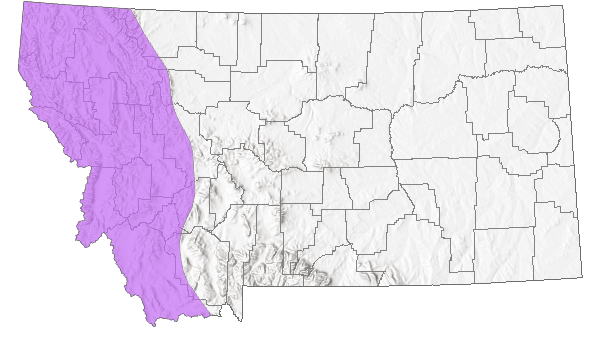
 Native
Native
Range Comments
Central Washington east to the continental divide in Montana, south through California and western Nevada to central Arizona (Glassberg 2001; Pyle 2002); from 30 m to at least 1830 m elevation in Oregon (Warren 2005). In Montana, reported from most counties west of or adjacent to the continental divide (Kohler 1980; Stanford and Opler 1993). Common to abundant (Glassberg 2001).
Observations in Montana Natural Heritage Program Database
Number of Observations: 21
(Click on the following maps and charts to see full sized version)
Map Help and Descriptions
Relative Density
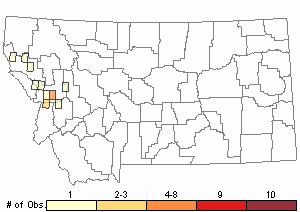
Recency

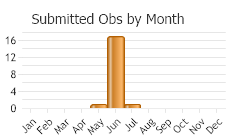
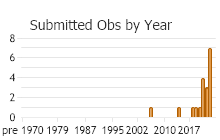
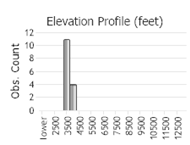 (Observations spanning multiple months or years are excluded from time charts)
(Observations spanning multiple months or years are excluded from time charts)
Migration
Non-migratory.
Habitat
Mountain and foothill shrubsteppe, sagebrush steppe, forest margins, open woodlands, meadows, forest roadsides, streamsides (Pyle 2002; James and Nunnallee 2011). Habitat in Montana not described but likely similar.
Food Habits
Larval food plants include Antirrhinum, Castilleja, Lonicera, Mimulus, Penstemon (several species), Plantago, Symphoricarpos (several species), and Verbascum (Ferris and Brown 1981; Bowers 1985; Scott 1986; Guppy and Shepard 2001; Pyle 2002; Warren 2005; James and Nunnallee 2011). Adults feed on flower nectar (including Anaphalis, Polygonum, Senecio), scat, and mud (Pyle 2002; James and Nunnallee 2011; Scott 2014; K. Dubois pers. obs.).
Reproductive Characteristics
Females lay eggs in large clusters (50-200 eggs/cluster) on undersides of hostplant leaves. Eggs hatch in 8-17 days. L1-L3 instars gregarious, build messy silk nests, reach L3 instar in 21-40 days. L2-L3 instars overwinter, commence feeding in 2-13 days after termination of diapause, develop to L4 instar in 7-23 days, may reenter dormancy more than once, probably reach L6 or possibly L7 instar before adulthood (depending on environmental conditions). Post-diapause larval instars solitary, feed openly, wander prior to pupation, pupate about 20 days after terminating diapause. Adults eclose (emerge from pupae) 10-20 days later (Scott 1979; James and Nunnallee 2011). Males patrol throughout the day or perch on exposed vegetation in clearings, hilltops seeking females (Scott 1986; Pyle 2002; James and Nunnallee 2011).
Stewardship Responsibility
References
- Literature Cited AboveLegend:
 View Online Publication
View Online Publication Bowers, M.D. 1985. Hostplant choice of checkerspot larvae: Euphydryas chalcedona, E. colon, and hybrids (Lepidoptera: Nymphalidae). Psyche 92: 39-48.
Bowers, M.D. 1985. Hostplant choice of checkerspot larvae: Euphydryas chalcedona, E. colon, and hybrids (Lepidoptera: Nymphalidae). Psyche 92: 39-48. Ferris, C.D. and F.M. Brown (eds). 1981. Butterflies of the Rocky Mountains. Univ. of Oklahoma Press. Norman. 442 pp.
Ferris, C.D. and F.M. Brown (eds). 1981. Butterflies of the Rocky Mountains. Univ. of Oklahoma Press. Norman. 442 pp. Glassberg, J. 2001. Butterflies through Binoculars: A Field Guide to the Butterflies of Western North America. Oxford University Press.
Glassberg, J. 2001. Butterflies through Binoculars: A Field Guide to the Butterflies of Western North America. Oxford University Press. Guppy, C.S. and J.H. Shepard. 2001. Butterflies of British Columbia: including western Alberta, southern Yukon, the Alaska Panhandle, Washington, northern Oregon, northern Idaho, northwestern Montana. UBC Press (Vancouver, BC) and Royal British Columbia Museum (Victoria, BC). 414 pp.
Guppy, C.S. and J.H. Shepard. 2001. Butterflies of British Columbia: including western Alberta, southern Yukon, the Alaska Panhandle, Washington, northern Oregon, northern Idaho, northwestern Montana. UBC Press (Vancouver, BC) and Royal British Columbia Museum (Victoria, BC). 414 pp. James, D.G. and D. Nunnallee. 2011. Life histories of Cascadia butterflies. Corvallis, OR: Oregon State University Press. 447 p.
James, D.G. and D. Nunnallee. 2011. Life histories of Cascadia butterflies. Corvallis, OR: Oregon State University Press. 447 p. Kohler, S. 1980. Checklist of Montana Butterflies (Rhopalocera). Journal of the Lepidopterists' Society 34(1): 1-19.
Kohler, S. 1980. Checklist of Montana Butterflies (Rhopalocera). Journal of the Lepidopterists' Society 34(1): 1-19. Opler, P.A. and A.B. Wright. 1999. A field guide to western butterflies. Second edition. Peterson Field Guides. Houghton Mifflin Company, Boston, Massachusetts. 540 pp.
Opler, P.A. and A.B. Wright. 1999. A field guide to western butterflies. Second edition. Peterson Field Guides. Houghton Mifflin Company, Boston, Massachusetts. 540 pp. Pyle, R.M. 2002. The butterflies of Cascadia: a field guide to all the species of Washington, Oregon, and surrounding territories. Seattle Audubon Society, Seattle, Washington. 420 pp.
Pyle, R.M. 2002. The butterflies of Cascadia: a field guide to all the species of Washington, Oregon, and surrounding territories. Seattle Audubon Society, Seattle, Washington. 420 pp. Scott, J.A. 1979. Hibernal diapause of North American Papilionoidea and Hesperioidea. Journal of Research on the Lepidoptera 18(3): 171-200.
Scott, J.A. 1979. Hibernal diapause of North American Papilionoidea and Hesperioidea. Journal of Research on the Lepidoptera 18(3): 171-200. Scott, J.A. 1986. The butterflies of North America: a natural history and field guide. Stanford University Press, Stanford, California.
Scott, J.A. 1986. The butterflies of North America: a natural history and field guide. Stanford University Press, Stanford, California. Scott, J.A. 2014. Lepidoptera of North America 13. Flower visitation by Colorado butterflies (40,615 records) with a review of the literature on pollination of Colorado plants and butterfly attraction (Lepidoptera: Hersperioidea and Papilionoidea). Contributions of the C.P. Gillette Museum of Arthopod Diversity. Fort Collins, CO: Colorado State University. 190 p.
Scott, J.A. 2014. Lepidoptera of North America 13. Flower visitation by Colorado butterflies (40,615 records) with a review of the literature on pollination of Colorado plants and butterfly attraction (Lepidoptera: Hersperioidea and Papilionoidea). Contributions of the C.P. Gillette Museum of Arthopod Diversity. Fort Collins, CO: Colorado State University. 190 p. Stanford, R.E. and P.A. Opler. 1993. Atlas of western USA butterflies: including adjacent parts of Canada and Mexico. Unpubl. Report. Denver and Fort Collins, Colorado 275 pp.
Stanford, R.E. and P.A. Opler. 1993. Atlas of western USA butterflies: including adjacent parts of Canada and Mexico. Unpubl. Report. Denver and Fort Collins, Colorado 275 pp. Warren, A.D. 2005. Lepidoptera of North America 6: Butterflies of Oregon, their taxonomy, distribution, and biology. Contributions of the C. P. Gillette Museum of Arthropod Diversity, Colorado State University. Fort Collins, Colorado. 406 pp.
Warren, A.D. 2005. Lepidoptera of North America 6: Butterflies of Oregon, their taxonomy, distribution, and biology. Contributions of the C. P. Gillette Museum of Arthropod Diversity, Colorado State University. Fort Collins, Colorado. 406 pp.
- Additional ReferencesLegend:
 View Online Publication
View Online Publication
Do you know of a citation we're missing? Allen, T.J., J.P. Brock, and J. Glassberg. 2005. Caterpillars in the field and garden: a field guide to the butterfly caterpillars of North America. Oxford University Press.
Allen, T.J., J.P. Brock, and J. Glassberg. 2005. Caterpillars in the field and garden: a field guide to the butterfly caterpillars of North America. Oxford University Press. Brock, J.P. and K. Kaufman. 2003. Kaufman Field Guide to Butterflies of North America. Houghton Mifflin Company, New York, NY 284 pp.
Brock, J.P. and K. Kaufman. 2003. Kaufman Field Guide to Butterflies of North America. Houghton Mifflin Company, New York, NY 284 pp.
- Web Search Engines for Articles on "Snowberry Checkerspot"
- Additional Sources of Information Related to "Insects"





